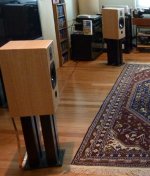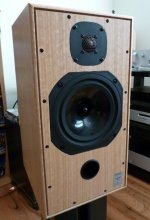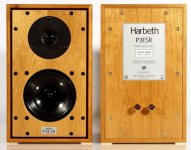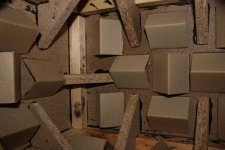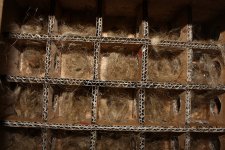limono all UK reviewers have to have a pinch of salt added. In the case of Practical HiFi a cart load of NaCl. I remember a group review of tube power amps including a Luxman that performed flawlessly measured well and was very well built. Not recommended as it was not musical or somehing. The UK amp TVA-1, measured badly, hummed and the paint flaked of and to top it of one of the amps cought fire during the test. But as it was "musical" it was recomended buy if the manufacturer could sort out these minor flaws...
I think you bring up and important thing with the rooms and ways of building, when I lived in the US I was surprised at the very flimsy way houses are built.
I think you bring up and important thing with the rooms and ways of building, when I lived in the US I was surprised at the very flimsy way houses are built.
Indeed, Dr. Boar, it is no coincidence that the smarmy, untrustworthy character in US films is usually a British HiFi reviewer. 
The Living Voice Avatar is an interesting loudspeaker more in the Lynn Olson "Ariel" mold, IMO. But a terrific read about it here which makes many good points about a speaker with a bit of magic:
6moons audio reviews: Edward Barker
Back to Harbeth. The Harbeth Compact 7ES-3 is an interesting take on the 8" bass, 1" tweeter idea that gathers some praise and may suit the British upper classes' drawing rooms:
StereoTimes --
I would guess we have said enough about the tiny LS3/5A style Harbeth P3ESR already, but working class people living in tiny British Brick Terrace houses may find them of interest, but probably can't afford them:
6moons audio reviews: Harbeth P3ES
Hope that helps. Clearly not for our American cousin's rooms which are evidently the size of aircraft hangars.
An externally hosted image should be here but it was not working when we last tested it.
The Living Voice Avatar is an interesting loudspeaker more in the Lynn Olson "Ariel" mold, IMO. But a terrific read about it here which makes many good points about a speaker with a bit of magic:
6moons audio reviews: Edward Barker
Back to Harbeth. The Harbeth Compact 7ES-3 is an interesting take on the 8" bass, 1" tweeter idea that gathers some praise and may suit the British upper classes' drawing rooms:
An externally hosted image should be here but it was not working when we last tested it.
StereoTimes --
I would guess we have said enough about the tiny LS3/5A style Harbeth P3ESR already, but working class people living in tiny British Brick Terrace houses may find them of interest, but probably can't afford them:
An externally hosted image should be here but it was not working when we last tested it.
6moons audio reviews: Harbeth P3ES
Hope that helps. Clearly not for our American cousin's rooms which are evidently the size of aircraft hangars.
Attachments
Sarcasm, no? I really feel no need to discuss cabinet construction any further since it is already covered for diy purposes:wow, thats a lot of nice DIY clones you have collected there
http://www.diyaudio.com/forums/multi-way/223174-interesting-read-i-found-lossy-cabinet-designs-harbeth.html#post3234256
If you want to build something as remotely good as a Harbeth, there are many aspects to consider. Personally, I like Alan Shaw and have no interest in dissecting his genius or secrets. I have the same high regard for Joachim Gerhard.
Now YOU tell ME something interesting.
Here some experimental and measurement data on different materials:
(Use google translate )
)
HSI :: Luidspreker kast materialen onderzoek
I once had a link to a german site where you could actually play examples of how the different marerials sound .... but cant find it anymore ....
I think a sandwich approach might give the best of more worlds ...
(Use google translate
HSI :: Luidspreker kast materialen onderzoek
I once had a link to a german site where you could actually play examples of how the different marerials sound .... but cant find it anymore ....
I think a sandwich approach might give the best of more worlds ...
HI, sreten, how did I guess you didn't lay out big bucks for your Spendors?
Such a tightwad!
Hi,
I bought them building a budget system for someone else and
ended up with them when he moved to Japan. £120 including
good stands for a used pair of Preludes (not bad). System also
had a rechargeable battery powered preamp / mosfet power
amplifier I aquired for him for £60, topped off with a IIX/Rega.
rgds, sreten.
HiFi Choice Best Buy and all that at about £280 at the time.
Detuned the port, inspected the x/o, and left it well alone.
Classic BBC type sound, probably still very nice today.
Monsterously sized magnet on the short coil bass/mid.
The side walls were damped chipboard, as thin as they appear above.
Front was plain 18mm chipboard, the rear plain 12mm ply, I recall.
Basically the BC1 bass/mid, built into a more cost effective speaker.
Last edited:
This thread is turning into the usual over-complication, I'd say.
If you want to build something as remotely good as a Harbeth, there are many aspects to consider.
no problem, its simple
Attachments
Found the link to the site where some folks have both measured and recorded the sound of different materials and sandwich combos .... take a look and listen
HAUPT
BR Baldin
Great link, thanks.
Note that some have a real audible pitch to them and others are more "tick" than "tonk". The bitumen damped ones are generally good.
These are double cabinets, front and back, so only cabinet radiation is heard.
Much confusion abounds about the Harwood experiments with most audiophiles offended by the thought that ever thicker walls wouldn't be always better.
The way to look at it is that you might be offered your choice of 20 pound cabinets. You could have 20 lbs of solid MDF, no damping. You could have 18 lbs of MDF and 2 lbs of surface damping, or you could have 10 lbs of MDF with 10 lbs of damping. Under those scenarios the 10/10 combo would be best. It would have the lowest level of resonance and the least audible cabinet breakthrough. Harwod even showed that if the choice was a 10 lb cabinet with 10 lbs of damping and a 20 lb cabinet with 10 lbs of damping, that the 10 lb cabinet was probably better, the more massive and rigid cabinet would respond less to the damping.
In the field of architectural acoustics they study this as wall breakthrough from one room to the next. Walls are rated for their TL transmission loss or STC (a single number for loss performance rather than a curve). It is well known that the limp suspended mass is an ideal case for issolation. It has no resonances and rises 6dB per Octave in its TL. This could be a heavy rubber sheet or lead power loaded curtain. Add stifness to the equation and you have a 2nd order system with a resonance somewhere. TL may increase at low frequencies (as well as high frequencies) but some midrange f will exist where the wall is at resonance and transmission will be total.
Damping is the only way to reduce transmission at resonance.
David S
yes, ofcourse knocking test is relevant
and then try put you ears close against the box surfaces while playing music
I don't see how knocking on a board is similar to air that is compressed and decompressed by a driver mounted to a box.
Hi, just read thruogh this thread. I am a Finn and I live in central Finland which is the home of Finnish Birch Plywood (Schauman, FinnForest). Wilhelm Schauman - Wikipedia, the free encyclopedia
I'm not an engineer but when thinking of sonic behaviour of different boards you should really get your hands on big boards. Hang it in the air and knock or hit with something soft and hard. The sound signature is different, sure. It's not related to surface hardness, not even if we are talking about solid wood. It is more related to density (nominal weight) and fiber properties.
The best way to stude behaviour of a speaker cabinet is to use a surface-attached microphone or laser (doppler). This kind of measurements have been made, but I can't find links now.
I don't own British speakers but it well known to the world that they think different. Every cadget must have it's soul and signature. Consider cars - Jaguar vs. Mercedes, bikes - Norton vs. BMW etc. The British tradition in sound reproduction follows that tradition often.
I'm not an engineer but when thinking of sonic behaviour of different boards you should really get your hands on big boards. Hang it in the air and knock or hit with something soft and hard. The sound signature is different, sure. It's not related to surface hardness, not even if we are talking about solid wood. It is more related to density (nominal weight) and fiber properties.
The best way to stude behaviour of a speaker cabinet is to use a surface-attached microphone or laser (doppler). This kind of measurements have been made, but I can't find links now.
I don't own British speakers but it well known to the world that they think different. Every cadget must have it's soul and signature. Consider cars - Jaguar vs. Mercedes, bikes - Norton vs. BMW etc. The British tradition in sound reproduction follows that tradition often.
They tested resonant behavior by "knocking" on the box. Has this relevance to a speaker driver mounted in a box?
The strongest drive to the box is the reaction force from the chassis driving the baffle. That is why compliant woofer mounting works well. Secondarily is the internal acoustical drive from the air pressure.
Exactly how you drive the box will slightly change the curve you see. For example piano designers are very particular about where the hammer hits the strings as it set the relative strength of the harmonics excited. Of course it doesn't change the harmonic frequencies.
Still a good relative test between cabinet constructions and I assume they excited each cabinet in the same manner.
David
Have we ever seen data that shows a cabinet resonating at exactly the same frequencies the knock-test suggests?
In the linked test a single panel (24x34cm) held between fingers was used.
In the linked test a single panel (24x34cm) held between fingers was used.
Last edited:
Years ago I found a short cut for testing the frequency response of trial woofer cones by mechanically tapping each one and doing an FFT of the impulse. It worked out quite close to the final frequency response as long as voice coil mass was accounted for. The manner of excitation is not a big factor.
David
David
Here is an academic paper on speaker cabinet vibrometry using LDV.
http://users.df.uba.ar/sgil/physics_paper_doc/papers_phys/ondas_optics/doppler.pdf
A speaker cabinet has it's origin of vibrations in the driver. 1) The driver agitates the front plate and that vibration is conducted to other parts of cabinet. 2) Driver induces sound waves inside the cabinet (differences in pressure) and waves are agitating walls and making them vibrate in same frequency and some resonances determined by multpile factors. 3) Some reflections hit back to the speaker membrane.
The material, form and construction, stuffing and braces of the cabinet alter these vibrations and reflections more or less. By purpose or by accident.
The disturbances we hear may come from the walls of the cabinet or the membrane of the driver. Both of these disturbances should be minimal. The dipole or TL or other "leaking" constructions make use of these phenomenoms in a more or less controlled way!
Musical instrument also get some of their characteristic sound from these phenomenoms. The quality and application of material makes the violin sing and the saxophone moan.
http://users.df.uba.ar/sgil/physics_paper_doc/papers_phys/ondas_optics/doppler.pdf
A speaker cabinet has it's origin of vibrations in the driver. 1) The driver agitates the front plate and that vibration is conducted to other parts of cabinet. 2) Driver induces sound waves inside the cabinet (differences in pressure) and waves are agitating walls and making them vibrate in same frequency and some resonances determined by multpile factors. 3) Some reflections hit back to the speaker membrane.
The material, form and construction, stuffing and braces of the cabinet alter these vibrations and reflections more or less. By purpose or by accident.
The disturbances we hear may come from the walls of the cabinet or the membrane of the driver. Both of these disturbances should be minimal. The dipole or TL or other "leaking" constructions make use of these phenomenoms in a more or less controlled way!
Musical instrument also get some of their characteristic sound from these phenomenoms. The quality and application of material makes the violin sing and the saxophone moan.
In the linked test a single panel (24x34cm) held between fingers was used.
yes, thats one way to determine plate ressonance
300year old method
btw, did you try to put one ear against the speaker box ?
please do, and tell us what you hear
It's all related to what is required. Stone and brick houses do well in the wind but poorly in earthquakes. For that reason we have near 100% stick frame residential structures. They shake rattle and roll better. That might be considered a flimsy house.I think you bring up and important thing with the rooms and ways of building, when I lived in the US I was surprised at the very flimsy way houses are built.
I find this thread has similar attributes. Both sides are right in their own way and in what they trying to achieve with the different designs. If a concrete cabinet offers no flex and sounds dead but is good to listener A, is that a bad thing? Conversely with the flexy cabinet. I can't think for a minute that it's a positive thing to have the cabinet walls moving...
...unless it sounds good. How could I be so arrogant as to suggest that's wrong to someone who appreciates it?
- Home
- Loudspeakers
- Multi-Way
- Interesting read I found on Lossy Cabinet designs by Harbeth
